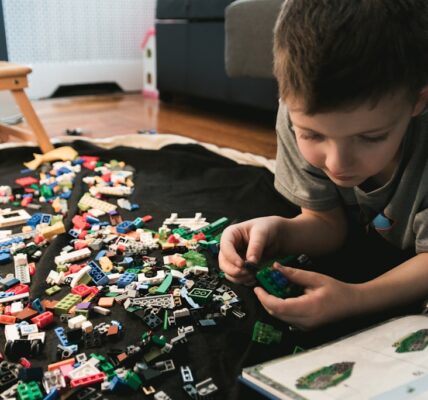Child development milestones are essential indicators of a child’s growth and progress from infancy through early childhood. These milestones encompass physical, cognitive, social, emotional, language, and behavioral aspects of development. They serve as guidelines for parents, caregivers, and educators to monitor progress and identify potential developmental delays or concerns.
Understanding these milestones is crucial for providing appropriate support and intervention to ensure children reach their full potential. Child development milestones are typically categorized into age ranges, such as 0-6 months, 6-12 months, 1-2 years, and 2-3 years. Each range is associated with specific developmental achievements children are expected to reach.
These milestones are general guidelines rather than rigid timelines, as individual children develop at different rates. However, they provide a valuable framework for assessing a child’s growth and development. Understanding these milestones enables parents and caregivers to create an environment that supports and nurtures a child’s overall development.
Key Takeaways
- Child development milestones are important markers of a child’s growth and progress in various areas of development.
- Physical development milestones include motor skills, coordination, and growth in height and weight.
- Cognitive development milestones involve language development, problem-solving skills, and memory development.
- Social and emotional development milestones include the ability to form relationships, regulate emotions, and show empathy.
- Language development milestones encompass the ability to understand and use language effectively, including vocabulary and grammar.
Physical Development Milestones
Infancy and Toddlerhood
In the first year of life, infants typically achieve significant physical milestones such as lifting their heads, rolling over, sitting up, crawling, and eventually walking. These milestones are crucial for building strength and coordination in their muscles and developing their gross motor skills.
Early Childhood
As children grow older, they continue to refine their motor skills, such as running, jumping, climbing, and throwing and catching objects. Fine motor skills also develop as children learn to grasp objects, feed themselves, and eventually write and draw. In the early years of childhood, physical development milestones also include the growth of primary and permanent teeth, as well as changes in body proportions.
Supporting Physical Development
Children’s bodies become more proportionate as they grow older, and they experience growth spurts at different stages of development. It is important for parents and caregivers to provide opportunities for physical activity and play to support children’s physical development. Engaging in activities such as sports, dance, and outdoor play can help children build strength, coordination, and endurance while promoting a healthy lifestyle.
Cognitive Development Milestones

Cognitive development milestones refer to a child’s intellectual growth and ability to think, reason, problem-solve, and learn. In the early years of life, infants begin to demonstrate cognitive milestones such as recognizing familiar faces, responding to sounds and voices, and exploring objects with their hands and mouths. As they grow older, children develop the ability to understand cause and effect, imitate actions and sounds, and engage in pretend play.
They also start to demonstrate memory skills by recalling familiar people, objects, and events. As children enter preschool age, cognitive development milestones include the ability to recognize letters, numbers, colors, shapes, and patterns. They also begin to develop early literacy and numeracy skills through activities such as storytelling, rhyming, counting, and sorting.
Problem-solving skills become more evident as children engage in puzzles, building blocks, and other hands-on activities that require critical thinking. It is important for parents and caregivers to provide a stimulating environment that encourages exploration, curiosity, and creativity to support children’s cognitive development.
Social and Emotional Development Milestones
| Age | Social and Emotional Development Milestones |
|---|---|
| 0-3 months | Smiling, making eye contact, and responding to familiar voices |
| 4-6 months | Showing interest in others, responding to emotions, and enjoying social play |
| 7-12 months | Developing attachment to primary caregivers, showing fear of strangers, and imitating others |
| 1-2 years | Expressing a range of emotions, showing independence, and engaging in parallel play |
| 3-5 years | Developing friendships, understanding and expressing emotions, and showing empathy |
Social and emotional development milestones encompass a child’s ability to form relationships, express emotions, regulate behavior, and develop a sense of self-awareness. In the early years of life, infants begin to demonstrate social milestones such as smiling in response to others, showing interest in faces, and seeking comfort from familiar caregivers. As they grow older, children start to engage in parallel play with peers and demonstrate empathy by showing concern for others’ emotions.
Emotional development milestones include the ability to express a wide range of emotions such as joy, sadness, anger, fear, and excitement. Children also begin to develop self-regulation skills by learning to manage their emotions and behavior in different social situations. As they enter preschool age, social development milestones include the ability to engage in cooperative play with peers, take turns, share toys, and follow simple rules.
Children also start to develop a sense of empathy by understanding others’ perspectives and feelings. It is important for parents and caregivers to provide a nurturing and supportive environment that allows children to develop healthy social relationships and emotional well-being. Encouraging positive social interactions, teaching emotional literacy, and modeling empathy can help children develop strong social and emotional skills.
Language Development Milestones
Language development milestones encompass a child’s ability to communicate through spoken language, gestures, and eventually written language. In the first year of life, infants begin to demonstrate language milestones such as cooing, babbling, responding to their name, and understanding simple words and commands. As they grow older, children start to produce their first words and expand their vocabulary through exposure to language-rich environments.
Language development milestones also include the ability to combine words into simple sentences, ask questions, engage in conversations, and express thoughts and ideas. Children also develop phonological awareness by recognizing sounds in spoken language and eventually learn to read and write. It is important for parents and caregivers to provide opportunities for language-rich interactions through talking, reading, singing, and storytelling to support children’s language development.
Behavioral Development Milestones

Behavioral development milestones encompass a child’s ability to regulate their actions, follow rules, demonstrate self-control, and exhibit pro-social behaviors. In the early years of life, infants begin to demonstrate behavioral milestones such as responding to routines, showing preferences for certain activities or objects, and demonstrating attachment behaviors towards familiar caregivers. As they grow older, children start to develop self-help skills such as feeding themselves, dressing independently, and using the toilet.
Behavioral development milestones also include the ability to follow simple instructions, understand rules and expectations, demonstrate empathy towards others, and exhibit self-control in different situations. Children also start to develop problem-solving skills by finding solutions to conflicts or challenges they encounter. It is important for parents and caregivers to provide consistent routines, clear expectations, positive reinforcement, and guidance to support children’s behavioral development.
Monitoring and Supporting Child Development Milestones
Monitoring child development milestones is essential for identifying any potential developmental delays or concerns that may require intervention or support. Parents can track their child’s progress by observing their achievements in different developmental domains such as physical abilities, cognitive skills, social interactions, language development, and behavioral regulation. Regular check-ups with pediatricians or early childhood professionals can also provide valuable insights into a child’s overall development.
Supporting child development milestones involves creating a nurturing environment that promotes growth in all developmental domains. This includes providing opportunities for physical activity and play to support physical development; offering stimulating activities that encourage exploration and creativity to support cognitive development; fostering positive social interactions and emotional well-being to support social and emotional development; engaging in language-rich interactions through talking, reading, singing, and storytelling to support language development; and providing consistent routines, clear expectations, positive reinforcement, and guidance to support behavioral development. In conclusion, understanding child development milestones is crucial for parents, caregivers, educators, and healthcare professionals to monitor a child’s growth and progress across different developmental domains.
By recognizing these milestones and providing the necessary support and intervention when needed, we can ensure that every child has the opportunity to reach their full potential in all aspects of their development.
If you’re interested in learning more about child development milestones, you may want to check out the article “The Importance of Tummy Time for Your Baby’s Development” on Baby and Mums. This article discusses the significance of tummy time in helping babies reach important developmental milestones, such as strengthening their neck and shoulder muscles, improving their motor skills, and preventing flat spots on their heads. It’s a great resource for parents looking to support their child’s development.
FAQs
What are child development milestones?
Child development milestones are a set of skills or abilities that most children can do at a certain age range. These milestones are used to track a child’s development and to ensure they are progressing as expected.
What are some examples of child development milestones?
Examples of child development milestones include sitting up, crawling, walking, speaking their first words, and understanding simple instructions. These milestones can vary slightly from child to child, but there is a general range of when these skills should be achieved.
Why are child development milestones important?
Child development milestones are important because they provide a framework for understanding a child’s growth and development. They can help identify any potential developmental delays or issues, and can also guide parents and caregivers in providing appropriate support and stimulation for their child.
How can parents track their child’s development milestones?
Parents can track their child’s development milestones by observing their child’s behavior and abilities, and comparing them to typical developmental milestones for their age. Pediatricians also regularly assess a child’s development during well-child visits and can provide guidance on what milestones to expect.
What should parents do if they are concerned about their child’s development milestones?
If parents are concerned about their child’s development milestones, they should speak with their pediatrician or a child development specialist. Early intervention is key in addressing any developmental delays or issues, so seeking professional guidance is important.




